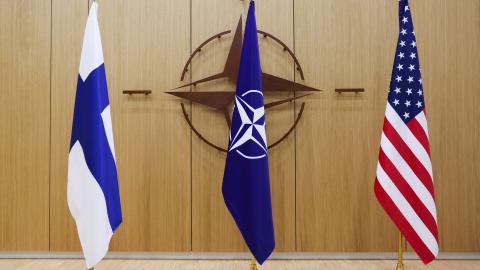Finland last week became NATO’s 31st member, an historic event that only 18 months ago would have been unthinkable — until Russia’s invasion of Ukraine changed everything.
For decades, Finland pursued a defense policy based on military non-alignment, a consequence of the Winter War (1939-40) when they repelled a large-scale Soviet invasion by themselves. Although world opinion was sympathetic to Finland’s situation, there was no meaningful international support other than a few thousand foreign volunteers. That experience shaped Finnish defense policy thinking for decades: they could not rely on anyone else, and should always be prepared to fight alone. This has been the main driver of Finnish defense policy since 1940. In practical terms, it meant Helsinki avoided joining organizations such as NATO during the Cold War.
However, Russia’s invasion of Ukraine in February 2022 has changed the geopolitical landscape of Europe in a way not seen since the Second World War. After Moscow’s aggression, the Finns opted to abandon military non-alignment and formally apply to join NATO.
The alliance was founded in 1949 as collective security against Soviet expansion into Western Europe. It operates on the basis of consensus and unanimity. No country is forced to join. Contrary to popular belief, there was never an agreement with Russia that NATO would not add members from the former Soviet Union. Its primary mission remains the territorial defense of its member states.
Some argue that Finland’s entry into NATO makes the alliance’s security more precarious because it shares such a long border with Russia — 1,340km, the longest in the EU. In fact, Finland’s membership of NATO strengthens the alliance. The size and scope of its armed forces are based on the decades-long assumption that it may have to fight Russia by itself, so it will be a net contributor to NATO’s security rather than a burden.
Its formidable military includes a 280,000-strong defense force, 900,000 trained reservists, thousands of armored vehicles, tanks, and artillery pieces, plus the recently purchased 64 American F-35 fighter jets, the first of which will arrive in 2026. In 2022 Finland spent marginally less on its military than the NATO target of 2 percent of GDP, but it maintains a robust defense industry and pledged to increase spending by $2.2 billion after the Russian invasion. As a percentage of GDP, Finland has given more to Ukraine than countries such as the US, Germany, France and the UK.
Helsinki also has the political will to use its armed forces when needed. Even when it was militarily non-aligned, it contributed to overseas military operations. Finland sent 2,500 troops, including special forces, to Afghanistan during the international operation there. It has also deployed hundreds of troops to NATO, EU, and US missions in Iraq (training Iraqi forces), the Balkans, and sub-Saharan Africa.
Finland’s membership of NATO is also a reminder that the alliance’s door is open to new members and should give hope to other countries hoping to join, such as Ukraine, Georgia, Bosnia-Herzegovina, and Kosovo. Even in strictly neutral countries such as Ireland, a public debate is beginning on the possibility of NATO membership because of the example set by Finland.
Meanwhile, NATO’s most immediate unfinished business is the prospective membership of Sweden. Finland and Sweden applied at the same time, but approval by NATO members must be unanimous and Stockholm’s application has been stalled by Turkey. The dispute is over Turkey’s demand that Stockholm extradite members of the outlawed PKK in Sweden who Ankara accuses of terrorism. Swedish courts have so far refused to do so. While negotiations have made progress, NATO’s leaders should do more to find common ground that allows Sweden to join NATO while addressing Turkey’s legitimate concerns about the PKK. The goal for Sweden’s membership of the alliance should be the NATO summit in Lithuania this summer.
NATO’s open-door policy for qualified countries has contributed greatly to transatlantic security since the first round of enlargement in 1952. Article 10 of the NATO treaty states that any European state “in a position to further the principles of this Treaty and to contribute to the security of the North Atlantic area” may apply to join, and Finland is the latest example.
Of course, the Kremlin is not happy with Finland’s membership. But NATO is a defensive alliance — as long as Russia has no plans to invade an alliance member, then it has nothing to fear.



















